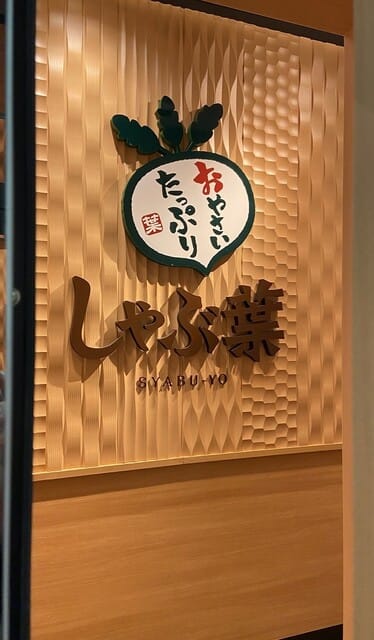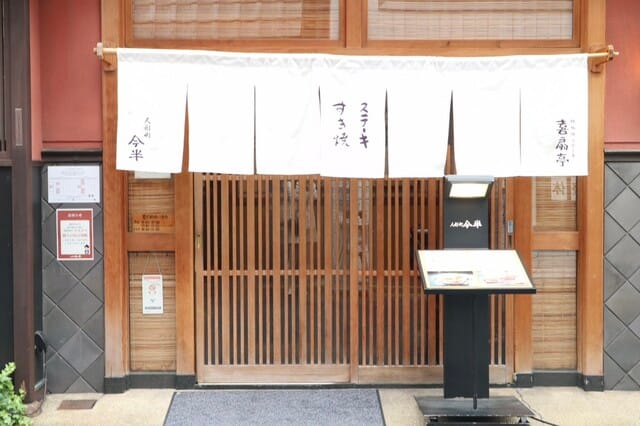Winter in Japan can be harsh, but I manage to get through it thanks to delicious hot pot dishes. Particularly, shabu-shabu and sukiyaki are one of my winter pleasures. Spending time with family and friends around a warm pot soothes both my mind and body.
The light and healthy taste of shabu-shabu makes me feel refreshed while eating. On the other hand, the sweet and savory broth of sukiyaki and its rich umami stimulate my appetite with its hearty feeling. I love both and choose depending on my mood for the day.
When entertaining foreign friends, I always serve either shabu-shabu or sukiyaki. Eating together around the pot makes conversation flow, and we can quickly become comfortable with each other. I'm happy to let them experience Japanese food culture while savoring the delicious meat.
In this article, I'll explain the basics of Japanese hot pot dishes, shabu-shabu, and sukiyaki. I'll also introduce chain restaurants where you can actually taste shabu-shabu and sukiyaki in Japan.
After reading this article, why don't you go out and try some piping hot shabu-shabu or sukiyaki?
About Japanese Hot Pot Dishes
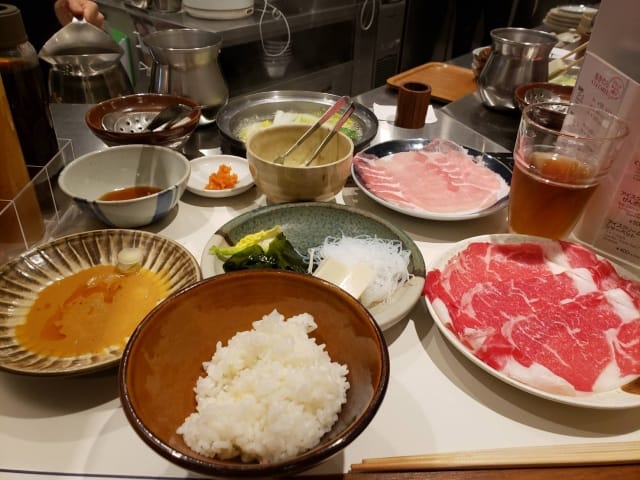
Hot pot dishes are essential to Japanese winter dining tables. Eating warm hot pots during the cold season has become established as part of Japanese culture.
The real pleasure of hot pot dishes is savoring the delicious soup, which has simmered various ingredients, to the very end. It's characterized by the use of various ingredients such as vegetables, meat, and seafood, and it's interesting how the contents change depending on the season and region.
Another charm of hot pot dishes is that they can be enjoyed according to the situation, from individual pots to those shared by large groups. They're also popular as healthy dishes with good nutritional balance.
Among these, shabu-shabu and sukiyaki are particularly popular as meat-based hot pot dishes. While Japanese people often eat them at restaurants, they also enjoy them at home. I, too, enjoy them with my family and sometimes even have "solo shabu-shabu" at home.
In Japan, hot pot dishes are so common that products with small amounts of soup for enjoying shabu-shabu alone are sold.
What is Shabu-Shabu?
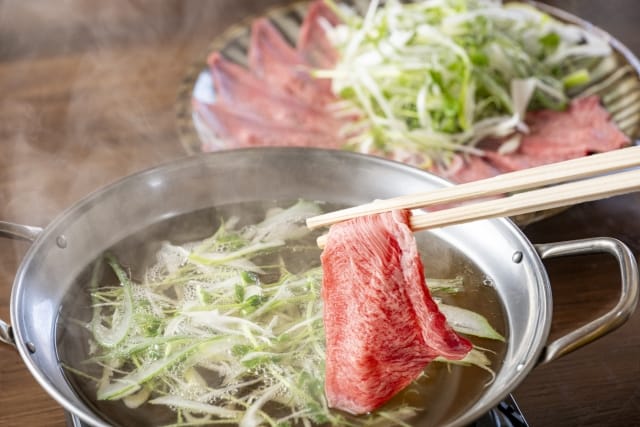
Shabu-shabu is a hot pot dish where thin slices of meat are dipped in heated soup for a few seconds before eating. Various meats can be used, including beef, pork, and chicken, and the appeal lies in how the flavor changes depending on the type of meat.
It's common to cook vegetables together and eat them with ponzu sauce or sesame sauce. I think the vegetable-rich soup after eating the meat is exquisite. It's especially popular among women as a healthy way of eating.
How to Eat Shabu-Shabu
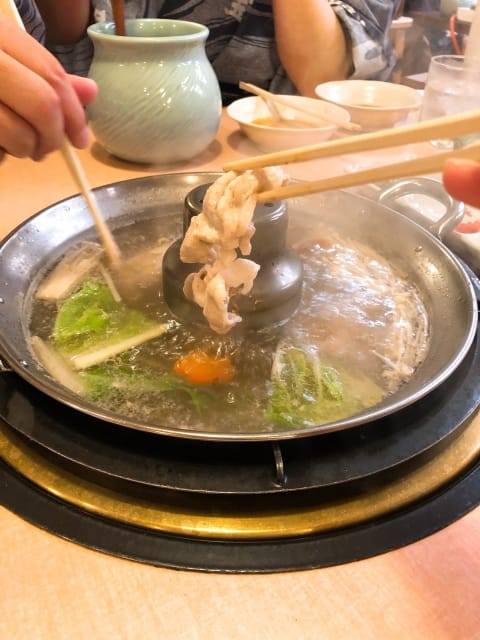
Eating shabu-shabu is simple. First, dip the thinly sliced meat for shabu-shabu in the heated soup for a few seconds. Once the meat is cooked, add vegetables and briefly cook them. When the vegetables are cooked, it's the signal that they're ready to eat.
It's delicious to eat with ponzu or sesame sauce. I recommend adding condiments like green onions or ginger according to your preference.
Finally, it's standard to make udon noodles or rice porridge with the soup that has absorbed the umami of meat and vegetables. I always look forward to this final arrangement to fully enjoy shabu-shabu.
When eating, be careful of burns. The key is to savor it slowly at your own pace. Also, when eating shabu-shabu, it's proper manners to use separate "serving chopsticks" to take the meat, rather than the chopsticks you're using. It's a no-no to take it directly with your own chopsticks, so please remember this.
What is Sukiyaki?
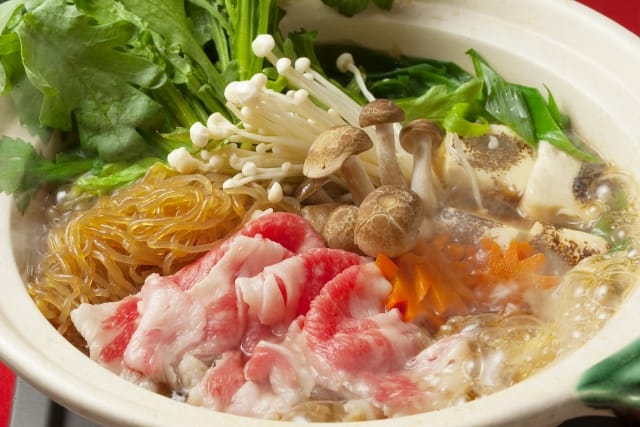
Sukiyaki is a hot pot dish where beef and vegetables are simmered in a sweet and savory broth called "warishita". The "warishita" is a seasoning made by combining soy sauce, sugar, mirin, and sake, and it's the key to sukiyaki's flavor. However, the way of eating can be slightly different in places like Osaka in the Kansai region.
When eating, it's common to dip the meat and vegetables in beaten raw egg, but this might be challenging for foreigners. However, don't worry, sukiyaki is delicious enough even without dipping in egg.
Finally, the point is to add udon noodles or rice at the end and let them absorb the warishita. I think sukiyaki is a dish that can be enjoyed deliciously down to the last drop.
Differences from Shabu-Shabu
While both sukiyaki and shabu-shabu are meat-based hot pot dishes, there are several differences.
In shabu-shabu, thin slices of meat are briefly dipped in heated soup before eating, while in sukiyaki, beef and vegetables are simmered in a sweet and savory broth. The taste also differs, with shabu-shabu being lighter, while sukiyaki has a stronger flavor.
Shabu-shabu uses meats other than beef, but sukiyaki mainly uses beef. Also, shabu-shabu is typically eaten with ponzu or sesame sauce, while sukiyaki is usually eaten by dipping in beaten raw egg.
How to Eat Sukiyaki
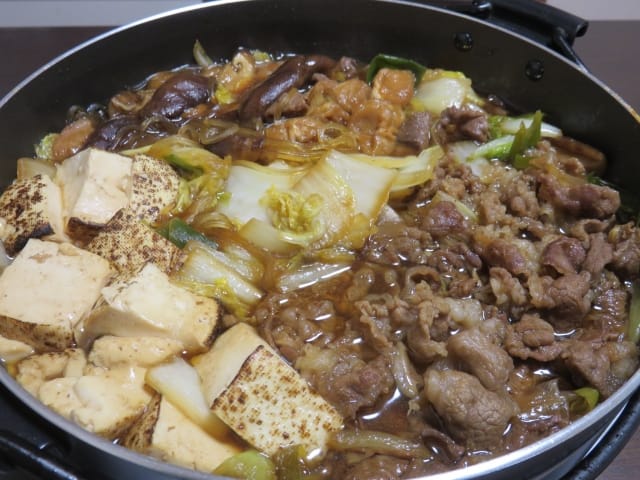
The way of preparing sukiyaki differs slightly between the Kanto style (like Tokyo) and the Kansai style (like Osaka). In the Kanto style, first, a seasoning called warishita is made by mixing soy sauce, sugar, mirin, and sake, then it's added to the pot before cooking the meat and vegetables.
On the other hand, in the Kansai style, warishita isn't prepared. Instead, sugar is sprinkled directly into the pot, and meat is placed on top. Once the meat is browned, soy sauce and sake are added for seasoning. It's more like a style close to "yakiniku" (grilled meat).
I'm more familiar with the Kanto style, so I always recommend adding rice porridge or udon noodles at the end to absorb the warishita.
Chain Restaurants Where You Can Enjoy Shabu-Shabu and Sukiyaki
While shabu-shabu and sukiyaki can be deliciously eaten at local restaurants, chain restaurants are recommended for first-timers. They're easy to enter and you can eat with peace of mind.
Also, while Japanese hot pot dishes are often eaten in winter, these chain restaurants offer shabu-shabu and sukiyaki all year round.
Here, I'll introduce three representative chain restaurants in Japan where you can enjoy shabu-shabu and sukiyaki.
Shabu-Yo
Source: Tabelog by kazuchi
Shabu-Yo is an all-you-can-eat shabu-shabu restaurant. Amazingly, you can enjoy shabu-shabu for a very reasonable price of 1,500-2,000 yen.
In my opinion, while the quality of meat is moderate, it's perfect for shabu-shabu beginners. I used to go there often when I was a student.
Website: https://www.skylark.co.jp/en/syabuyo/
Shabusai
Source: Tabelog by Shabusai
Shabusai is an all-you-can-eat restaurant where you can choose between shabu-shabu and sukiyaki. It's in the same price range as Shabu-Yo, but from my experience, I feel Shabusai is slightly more delicious.
If there's a Shabusai near your accommodation, I recommend giving it a try. I think you'll be satisfied.
Website: https://shabu-sai.com/
Imahan
Source: Tabelog by sugaya_azusa
Imahan is a high-end sukiyaki chain restaurant mainly operating in Tokyo. You can choose between shabu-shabu and sukiyaki, but sukiyaki is especially recommended.
Lunch costs about 5,000-8,000 yen per person, and dinner costs about 10,000-20,000 yen. It's a bit high-end, but if you want to try luxury shabu-shabu or sukiyaki, I encourage you to give it a try.
Many of their branches require phone reservations, which might be challenging, but it's a chain restaurant worth remembering if you want to eat high-end shabu-shabu or sukiyaki.
Website: https://imahan-tokyo.com/official/
In this article, I've introduced Japanese hot pot dishes, especially shabu-shabu and sukiyaki.
When winter comes, I always go out to eat shabu-shabu or sukiyaki. The time spent chatting with family and friends around the pot is truly blissful.
While you can eat shabu-shabu and sukiyaki at chain restaurants all year round, I think warming up both body and soul with a hot pot dish in the cold winter is the real pleasure of Japanese winters.
I hope you'll try and experience their charm for yourself!

